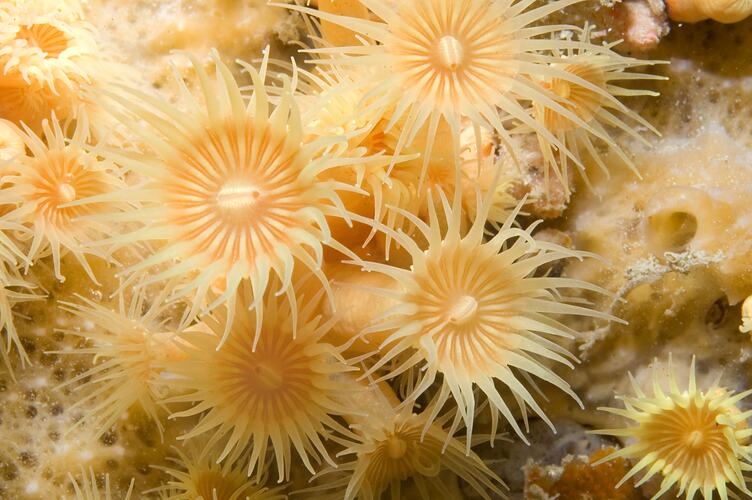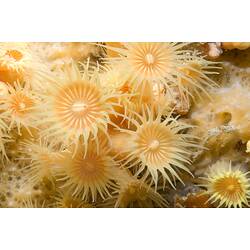General Description
Colonial, around 20 stalked polyps to a colony. Two whorls of narrow tentacles around the oral disc at the top of the polyp, one extending up, one down. Polyp trunk up to 1 cm wide.
Biology
Zoanthids are not anemones. They look superficially like them but zoanthids usually occur as colonies rather than individual polyps. They are also sometimes called soft-corals, but are not true soft-corals (which are a different order of Cnidarians). Like all Cnidarians, zoanthids have stinging cells that are used to disable prey, allowing these non-moving (sessile), soft-bodied animals to eat moving food. Some zoanthid species have photosynthetic zooxanthellae living in their tissue that supplement the polyps' food intake. Many species, including the Yellow Zoanthids, incorporate sand into the layer between the inner and outer cell layers (mesoglea), possibly to help support them, possibly for defensive purposes. Zoanthids are quite common, but have been very little studied in Australia and, despite there probably being many species in several genera, few have been named. Some species are prized for the aquarium trade because of their beautiful colours.
Distribution
Mainland Australian and Tasmanian coasts.
Habitat
Under overhangs and on rocky vertical walls, to depth of 70 m.
More Information
-
Animal Type
-
Animal SubType
-
Brief Id
Double fringe of tentacles, colonial.
-
Colours
Yellow
-
Habitats
-
Diet
Plankton or Particles
-
Endemicity
-
Commercial
Yes
-
Conservation Statuses
CITES: Not listed, FFG Threatened List: Not listed, DSE Advisory List: Not listed, IUCN Red List: Not listed
-
Depths
Deep ( > 30 m)
-
Water Column Locations
On or near seafloor
-
Taxon Name
-
Common Name
Zoanthid
-
Other Names
Zonathid Anemone
-
Phylum
-
Class
-
Subclass
-
Order




